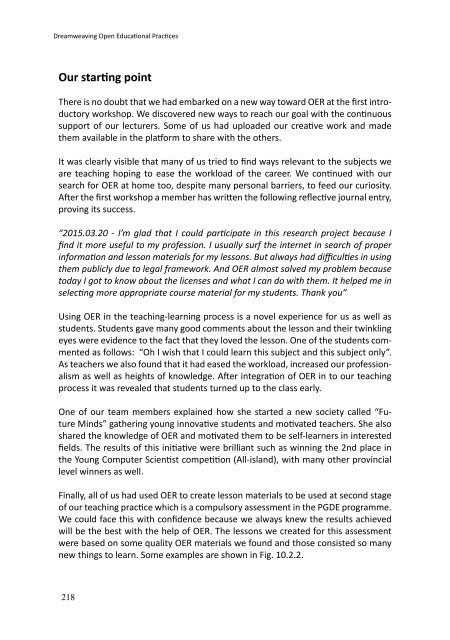Dreamweaving Open Educational Practices
PVvv306Yd9F
PVvv306Yd9F
Create successful ePaper yourself
Turn your PDF publications into a flip-book with our unique Google optimized e-Paper software.
<strong>Dreamweaving</strong> <strong>Open</strong> <strong>Educational</strong> <strong>Practices</strong><br />
Our starting point<br />
There is no doubt that we had embarked on a new way toward OER at the first introductory<br />
workshop. We discovered new ways to reach our goal with the continuous<br />
support of our lecturers. Some of us had uploaded our creative work and made<br />
them available in the platform to share with the others.<br />
It was clearly visible that many of us tried to find ways relevant to the subjects we<br />
are teaching hoping to ease the workload of the career. We continued with our<br />
search for OER at home too, despite many personal barriers, to feed our curiosity.<br />
After the first workshop a member has written the following reflective journal entry,<br />
proving its success.<br />
“2015.03.20 - I’m glad that I could participate in this research project because I<br />
find it more useful to my profession. I usually surf the internet in search of proper<br />
information and lesson materials for my lessons. But always had difficulties in using<br />
them publicly due to legal framework. And OER almost solved my problem because<br />
today I got to know about the licenses and what I can do with them. It helped me in<br />
selecting more appropriate course material for my students. Thank you”<br />
Using OER in the teaching-learning process is a novel experience for us as well as<br />
students. Students gave many good comments about the lesson and their twinkling<br />
eyes were evidence to the fact that they loved the lesson. One of the students commented<br />
as follows: “Oh I wish that I could learn this subject and this subject only”.<br />
As teachers we also found that it had eased the workload, increased our professionalism<br />
as well as heights of knowledge. After integration of OER in to our teaching<br />
process it was revealed that students turned up to the class early.<br />
One of our team members explained how she started a new society called “Future<br />
Minds” gathering young innovative students and motivated teachers. She also<br />
shared the knowledge of OER and motivated them to be self-learners in interested<br />
fields. The results of this initiative were brilliant such as winning the 2nd place in<br />
the Young Computer Scientist competition (All-island), with many other provincial<br />
level winners as well.<br />
Finally, all of us had used OER to create lesson materials to be used at second stage<br />
of our teaching practice which is a compulsory assessment in the PGDE programme.<br />
We could face this with confidence because we always knew the results achieved<br />
will be the best with the help of OER. The lessons we created for this assessment<br />
were based on some quality OER materials we found and those consisted so many<br />
new things to learn. Some examples are shown in Fig. 10.2.2.<br />
218


